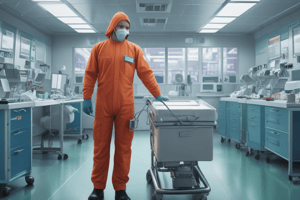Podcast
Questions and Answers
What are the six components of the chain of infection?
What are the six components of the chain of infection?
The six components of the chain of infection are: infectious agent, reservoir, portal of exit, mode of transmission, portal of entry, and susceptible host.
What are the three main methods of preventing the spread of biological hazards?
What are the three main methods of preventing the spread of biological hazards?
The three main methods of preventing the spread of biological hazards are: personal protective equipment (PPE), proper handwashing, and disposal of biological wastes.
What is the recommended procedure for handwashing?
What is the recommended procedure for handwashing?
The recommended procedure for handwashing includes wetting hands with warm water, applying antimicrobial soap, rubbing to form a lather and create friction, thoroughly cleaning between fingers and up to the wrist for at least 15 or 20 seconds, rinsing hands in a downward position, drying with a paper towel, and turning off faucets with a clean paper towel to prevent recontamination.
What is the recommended dilution ratio for sodium hypochlorite for effective disinfection?
What is the recommended dilution ratio for sodium hypochlorite for effective disinfection?
Describe the biohazard symbol.
Describe the biohazard symbol.
What is the recommended first aid for chemical spills?
What is the recommended first aid for chemical spills?
What should be done when a fire is discovered?
What should be done when a fire is discovered?
Explain the steps of using a fire extinguisher.
Explain the steps of using a fire extinguisher.
What are the four types of fire and their corresponding fire extinguishers?
What are the four types of fire and their corresponding fire extinguishers?
What are some general precautions for avoiding physical hazards?
What are some general precautions for avoiding physical hazards?
What are some examples of ergonomic hazards?
What are some examples of ergonomic hazards?
What are the six components of the chain of infection?
What are the six components of the chain of infection?
What are the recommended personal protective equipment (PPE) for working in a clinical lab?
What are the recommended personal protective equipment (PPE) for working in a clinical lab?
What is the proper procedure for handwashing?
What is the proper procedure for handwashing?
Describe the steps in using a fire extinguisher.
Describe the steps in using a fire extinguisher.
What are the four types of fire and their corresponding fire extinguishers?
What are the four types of fire and their corresponding fire extinguishers?
What is the recommended duration for cleaning fingers and wrists?
What is the recommended duration for cleaning fingers and wrists?
What does the yellow quadrant in the NFPA hazard classification represent?
What does the yellow quadrant in the NFPA hazard classification represent?
What is the best method of radioactive waste disposal for radioiodine?
What is the best method of radioactive waste disposal for radioiodine?
How should acid spills on floors be managed?
How should acid spills on floors be managed?
What is the purpose of the biohazard symbol?
What is the purpose of the biohazard symbol?
What is the recommended first aid for alkali or acid burns in the eye?
What is the recommended first aid for alkali or acid burns in the eye?
Flashcards are hidden until you start studying




